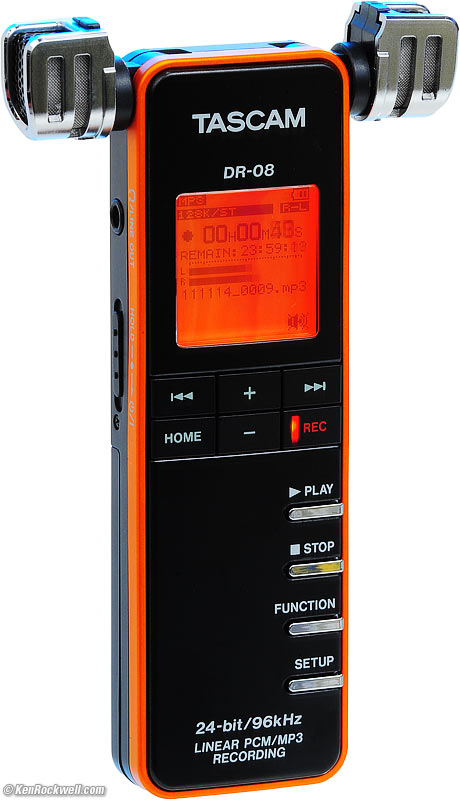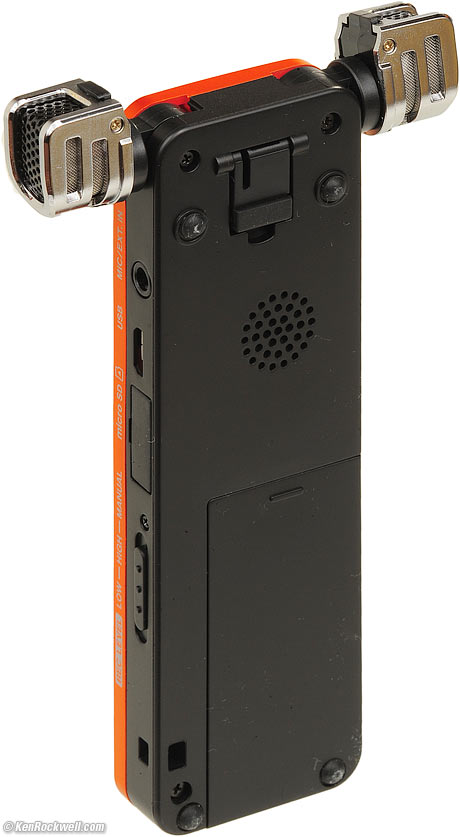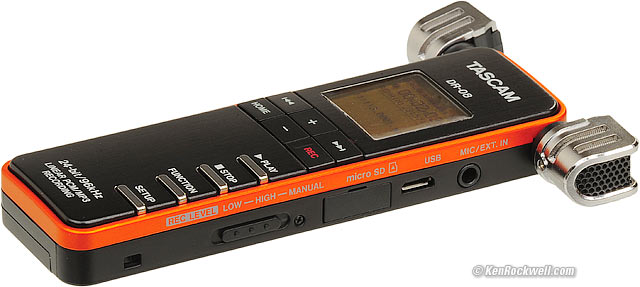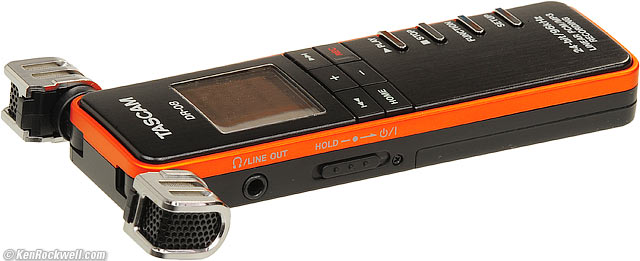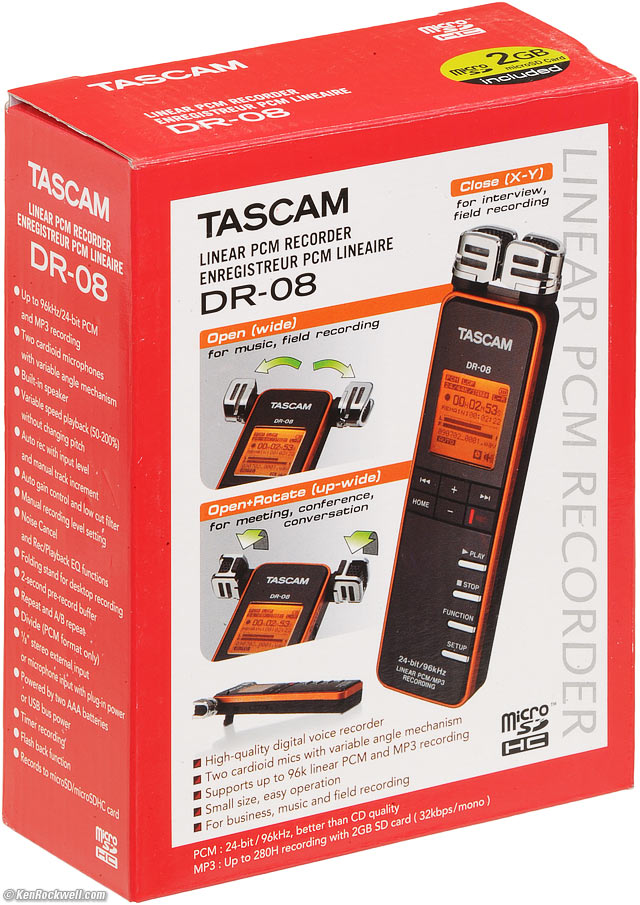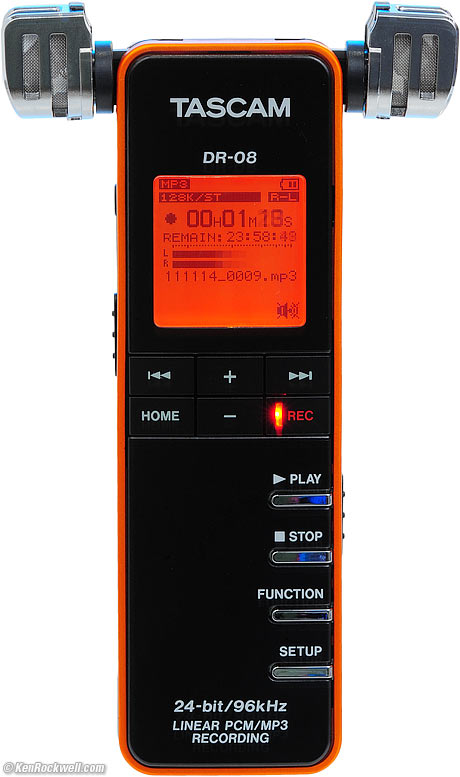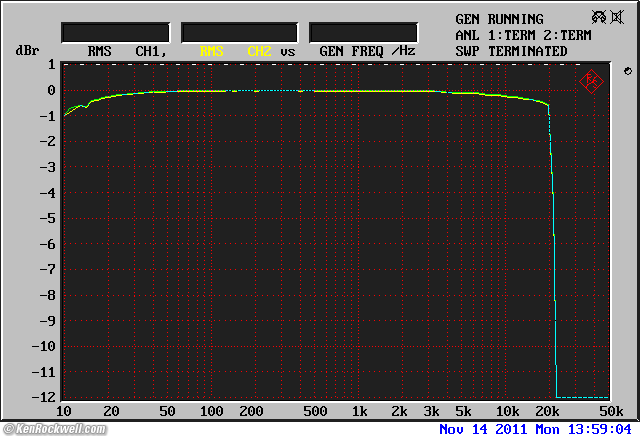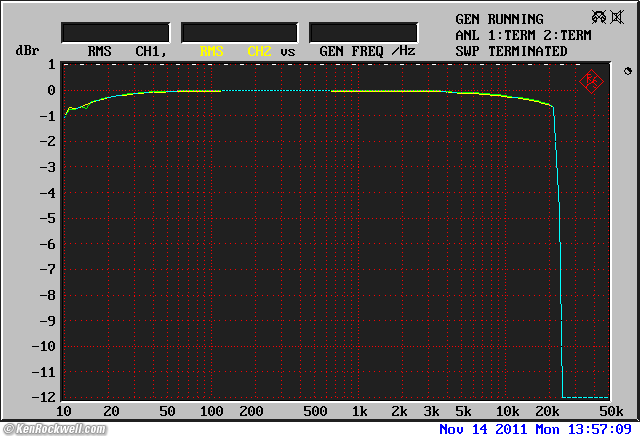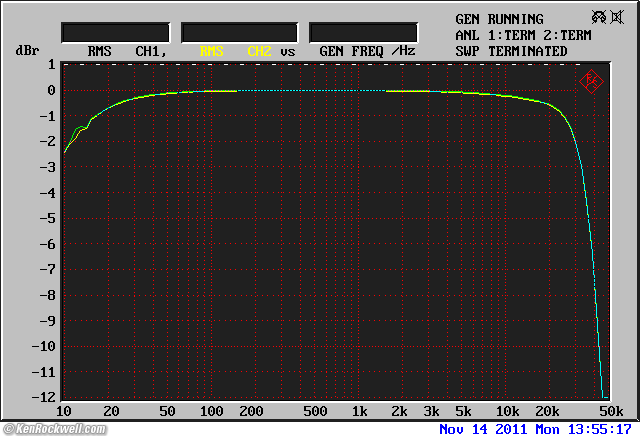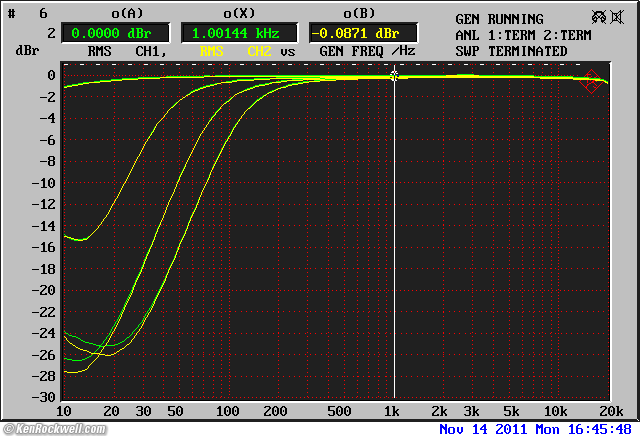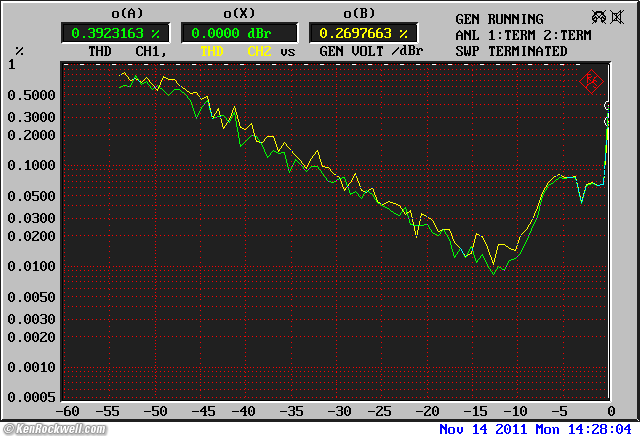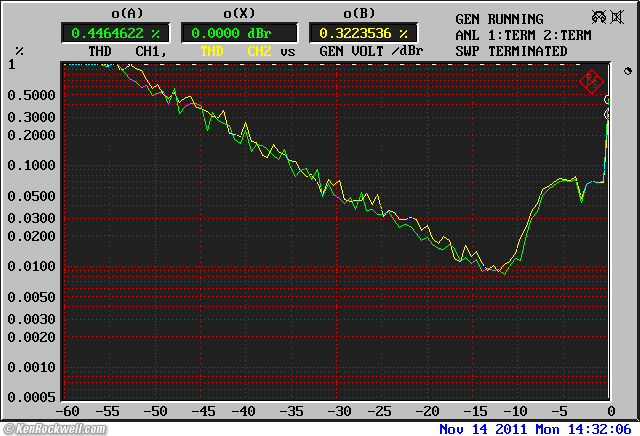Home Donate New Search Gallery Reviews How-To Books Links Workshops About Contact
Tascam DR-08
Portable Digital Audio Recorder
© 2011 KenRockwell.com. All rights reserved.
Intro Specs Performance Measurements Usage Recommendations More
Tascam DR-08 (2.857oz./81.1g with Ni-MH and included 2GB micro SD card, about $80). larger. This free website's biggest source of support is when you use these links, especially this link directly to it at Adorama, directly to it at Amazon, when you get anything, regardless of the country in which you live. HINT: Use use coupon code S1231399 on checkout at Adorama to get it, delivered, for under $80. Thank you! Ken.
November 2011 TASCAM Reviews Audio Reviews All Reviews
Sample Recording: 6MB, 6-minutes at 128 kbps MP3 Stereo
Introduction top
Intro Specs Performance Measurements Usage Recommendations More
|
Adorama pays top dollar for your used gear. I use Adorama, Amazon, eBay, Ritz, B&H, Calumet, J&R and ScanCafe. I can't vouch for ads below.
|
The Tascam DR-08 is a dinky little 96 kHz/24-bit portable digital recorder that makes great-sounding files. It runs on two AAA cells or USB power. It comes complete with its own swiveling microphones.
The DR-08 is a cheap little thing that weighs less than 3 ounces (81g) complete with card and batteries. For voice, conference, speech, lecture, presentation and spoken word recording, vocal intelligibility is much better than with the Sony PCM-M10, which is better suited to music recording.
This little recorder works for for anything, especially audio for DSLR or other video. You put this recorder up at your subject and let it run, then use software like Plural Eyes to sync the audio to video later. You shoot from where you need to shoot, and the audio is recorded clear and up-close in either direct-to-MP3 or up to glorious 96kHz/24-bit digital stereo separately from your DSLR without any big mics on-camera, or even any wires.
It feels dinky and it is, but for $80, it makes files that sound as good as files from the Sony PCM-M10, and in much wider stereo than from the Zoom H4n. I personally have over thirty years of experience in digital audio recording and prefer the Sony PCM-M10 for hi-fi use, but if $80 is your budget, this is a swell-sounding, if dinky, recorder. If you can hear any difference between the files made by the DR-08 and the more expensive recorders, the DR-08 recordings are actually easier to understand!
Since most DLSR and video is recording voice on location, this little recorder actually brings back better audio than a music-oriented recorder like the Sony PCM-M10. Listen to the sample files recorded at the same time with each recorder and you'll hear the difference.
If you can see the DR-08's teeny-tiny LCD, it is super-easy to figure out and immediately record broadcastable files. When the REC light is blinking, you're ready, and when REC is solid, you're rolling. Want to make a great downloadable file? Just set it to 128 kbps MP3, record, and upload. Done, although the tiny and fewer buttons make this less pleasant to use than larger recorders — but likewise, the Tascam DR-08 is much easier to carry around.
Rear, Tascam DR-08. bigger.
Right, Tascam DR-08. bigger.
Left, Tascam DR-08. bigger.
Features
Mics swivel and rotate.
44.1, 48 and 96 kHz (ksps, kilo-samples per second) recording at 16- or 24-bits as WAV files.
Mono recording at 44.1/16.
MP3 recording from 64 kbps to 320 kbps.
Mono MP3 recording at 160, 96, 64 and 32 kbps.
Built-in speaker.
Auto and manual record level control.
Two-second pre-recording.
Automatic recording (also works with the two-second pre-record).
Timer Recording.
Selectable recording EQ.
Programmable lo-cut filter.
Stealth (all lights off) mode.
Selectable playback EQ.
Playback tempo (speed) variable from 50-200% in 10% increments without changing pitch.
Shortcomings
Dinky construction.
Almost illegible tiny LCD.
Microphones swivel, but seem delicate. Be careful when throwing the DR-08 in a pocket.
You'll hear any handling in the recording; don't touch while rolling.
No Margin (maximum held level) display, nor do the peak indicators hold indefinitely. The peak indicators are just a pixel or two on the tiny LCD; good luck seeing them.
No analog line-level inputs: needs an external pad to record from a board, mixer, preamp or other recorder into the mc-level inputs, but that's not why people buy these.
No dedicated digital audio inputs or outputs, except as files.
No time-code.
Only one analog output: the headphone jack is the line output jack.
No level knobs; just up-down clickers for mic and headphone level that will be heard on the recordings if you change either while rolling with the built-in mics.
No apparent ability to use as a USB DAC or USB ADC.
Included
Box, Tascam DR-08. bigger.
Two Maxell alkaline AAA cells.
2 GB card already in the slot and ready to roll.
Micro USB cable.
Genuine printed manual.
Specifications top
Intro Specs Performance Measurements Usage Recommendations More
See also the Tascam DR-08 Users Manual and the Tascam DR-08 fluff page.
It has no digital audio inputs or outputs, except as files. It has only analog audio inputs and outputs. These are:
Input
Two movable cardioid mics.
61mm spacing maximum (36% of the human head's natural 170mm spacing).
3.5mm stereo socket:
Set to mic input:
200kΩ
Nominal input levels
High: -45 dBV.
Low: -61 dBV.
Maximum input levels
High: -29 dBV.
Low: -45 dBV.
Set to EXT input:
200k Ω
Nominal input levels:
High: -19 dBV.
Low: -31 dBV.
Maximum input levels:
High: -3 dBV.
Low: -3 dBV.
Storage
microSD cards.
Frequency Response
20 ~ 20,000 Hz +1/–3 dB at 44.1 ksps (kHz).
20 ~ 22,000 Hz +1/–3 dB at 48 ksps (kHz).
20 ~ 32,000 Hz +1/–3 dB at 96 ksps (kHz).
Output
One 3.5mm stereo output with variable level. Use this either for headphones or for a variable line-level output, but not both at the same time.
200 Ω.
Nominal output: -18 dBV.
Maximum Output: -2 dBV or 5 mW per channel into 16 Ω.
Built-in speaker, 100 mW mono.
Micro-B USB 2.0 mass storage connector.
Power
Two Alkaline or Ni-MH AAA cells.
Rated about 6 hours.
Power consumption: 1 Watt max.
USB power.
Display
TIny black-and-white 96 x 96 pixel LCD.
Daylight visible, orange backlight.
Size
15 x 37 × 139.5 millimeters HWD.
0.591 x 1.457 × 5.492 inches HWD.
Weight
2.857oz. (81.1g), actual measured with Ni-MH and included 2GB micro SD card.
1.807 oz. (56g), stripped, rated.
Environment
0º ~ 40º C operating.
Quality
Made in China.
Performance top
Intro Specs Performance Measurements Usage Recommendations More
Sound quality depends far more on your ability as a recording engineer than on this recorder. Placement is everything. Recording engineers spend careers learning better and better ways to place microphones.
Used properly for video and DSLR audio, the files should be indistinguishable from the files made with more expensive recorders, and in my testing, actually rendered speech more intelligibly than other recorders, making the DR-08's recordings better for most video and DSLR applications.
Sound
Listen to this Sample Recording: 6MB, 6-minutes at 128 kbps MP3 Stereo to hear for yourself. The recorder sat 2 meters (six feet) away from the class and the presenters.
Compared to the better-for-music Sony PCM-M10, there was less rumble in the recordings made by the DR-08, and voices were easier to understand and hear against the venue's background noise.
Used in AUTO levels, the files from this DR-08 are louder with softer speech than were the files from the Sony PCM-M10.
The headphone and LINE output levels are anemic, a little less than from an iPod Touch.
Ergonomics
Tascam DR-08. larger.
It turns on in just a few seconds, much faster than the Zoom H4n.
Once you get over how tiny and cheap it feels, it's easy to use. It's not as easy to use as the Zoom H4n or Sony PCM-M10 because this Tascam DR-08 has fewer and tinier buttons that all look alike, and its LCD is so small that it's almost illegible.
Big deal, for $80 its a very competent recorder.
There is no confidence head; you don't really know that your file will play back until you're done.
The level meters are almost invisible and of little use. None of the levels are marked; if you have a magnifier, there are tiny one-pixel ticks at what are probably -50, -40, -20, -10, -6 and -3 dB. The OVER indicators is only a one-pixel wide bar at the top, good luck noticing it.
AUTO levels works very well. I'd use that.
There is no recording level Margin indicator and no permanent peak hold, so you have to watch the meters the whole time to set your levels. Use AUTO levels.
You'll hear the clicking of the up-down level pushbuttons if you click them while rolling with the built-in mics.
The units of recording and playback level settings are arbitrary. They sadly are not in decibels.
There are four rubber bumpers on the bottom that work great when set on a table.
There is no helper to pull out the batteries, you may need something pointy to work them out.
Data
Files are titles in the form "YYMMDD_####.mp3."
#### increments for each file. It does not reset each day as they do on the Sony PCM-M10.
Measurements top
Intro Specs Performance Measurements Usage Recommendations More
All measurements were made as powered by two Sanyo AAA Eneloop. The advantage of this is complete isolation as compared to using USB power.
I used a $50,000 Rohde & Schwarz UPL audio analyzer to perform these measurements.
Input Levels
LINE external input selected in a menu:
Input Gain set to |
RMS Input for 0 dBFS |
Relative Attenuation |
20 |
24mV |
0.00 dB |
19 |
28 mV |
-1.28 dB |
18 |
33 mV |
-2.58 dB |
17 |
39 mV |
-3.90 dB |
16 |
45 mV |
-5.28 dB |
15 |
53 mV |
-6.63 dB |
14 |
62 mV |
-8.00 dB |
13 |
74 mV |
-9.42 dB |
12 |
87 mV |
-10.85 dB |
11 |
102 mV |
-12.29 dB |
10 |
121 mV |
-13.73 dB |
9 |
142 mV |
-15.20 dB |
8 |
170 mV |
-16.68 dB |
7 |
202 mV |
-18.14 dB |
6 |
239 mV |
-19.60 dB |
5 |
283 mV |
-21.08 dB |
4 |
336 mV |
-22.57 dB |
3 |
400 mV |
-24.06 dB |
2 |
474 mV |
-25.55 dB |
1 |
564 mV |
-27.05 dB |
0 |
672 mV |
-28.55 dB |
EXT. MIC external input selected in a menu:
Input Gain set to |
RMS Input for 0 dBFS |
35 |
1.2 mV |
30 |
1.8 mV |
20 |
6.1 mV |
15 |
14.2 mV |
10 |
33 mV |
5 |
79 mV |
1 |
157 mV |
0 |
185 mV |
Note: when recording from the built-in microphones, the level settings also go from 0 to 35.
Channel Balance
In manual level control, channels were within a tenth of a dB of each other.
Output Levels
Output Load Impedance |
MOL at 0.1% THD at 1 kHz |
200kΩ |
1.224V |
600 Ω |
373mV |
300 Ω |
366mV |
With 0 dBFS at 1 kHz, maximum undistorted output level setting with a 200k Ω load is 33.
Output Impedance
Actual analog output source impedance measures 22.0 Ω at 1 kHz.
Output Idle Noise
A-weighted with 200kΩ load while idle (neither playing nor recording):
Output Gain set to |
Idle Output Noise |
35 |
-93.5 dBV A |
34 |
-94.3 dBV A |
33 |
-95.0 dBV A |
32 |
-95.5 dBV A |
31 |
-96.3 dBV A |
30 |
-97.0 dBV A |
20 |
-105.5 dBV A |
10 |
-107 dBV A |
0 |
-108 dBV A |
Frequency Response
Measured at LINE input, 100 mV input, input level set to 10, output level set to 20 for 475mV output:
Tascam DR-08 Frequency Response, 44.1/16-bits. (R&S UPL.)
Tascam DR-08 Frequency Response, 48/16-bits. (R&S UPL.)
Tascam DR-08 Frequency Response, 96/16-bits. (R&S UPL.)
As expected, frequency response is more than flat enough for its intended application, but not as flat as a professional DAT recorder. It meets its specifications.
Low-Cut Filters
Tascam DR-08 Low-Frequency Filter Responses, Line inputs. (R&S UPL.)
This shows the OFF and the 40 Hz, 80 Hz and 120 Hz menu settings.
These aren't very impressive, they look more like a dipped graphic EQ than a low-cut filter, but they should work as intended.
Distortion
THD (d2-d9) was measured from the LINE input at 100 mV input maximum for 0 dBFS, input level was set to 11, output level was set to 34. The input level was swept from 100 µV to 100 mV.
Tascam DR-08 THD versus level, 44.1/16-bit. (R&S UPL.)
Tascam DR-08 THD versus level, 96/24-bit. (R&S UPL, roll mouse-over to compare to 44.1/16.)
THD is a little better than the $300 Zoom H4n. Not bad for an $80 recorder, but no match for a DAT recorder or the Sony PCM-M10.
Noise
Signal-to-Noise Ratios
-79 dB (A-weighted) at 96/24 bits WAV.
-78 dB (A-weighted) at 44.1/24 bits WAV.
-78 dB (A-weighted) at 44.1/16 bits WAV.
-77 dB (A-weighted) at MP3/128kbps.
These are poor readings, about 10 dB worse than the Sony PCM-M10 or Zoom H4n.
Performance doesn't improve at the 24-bit or 96 kHz settings.
I can't stress strongly enough that only an expert recordist will ever hear this noise or any of the other measured defects. Most people, even many pros, never get their gain structures right and have more noise coming out of their mixers and consoles than any of these recorders have.
Therefore, I wouldn't worry about this. As you can hear in my Sample Recording, there is still more natural noise in the room than in the recorder.
Usage top
Intro Specs Performance Measurements Usage Recommendations More
The Tascam DR-08 recorder works for for anything, especially for audio for DSLR or other video. You put this recorder up at your subject and let it run, then use software like Plural Eyes to sync the audio to video later. You shoot from where you need to shoot, while the audio is recorded clear and up-close in either direct-to-MP3 or up to glorious 96kHz/24-bit digital stereo, separately from your DSLR without any big mics on-camera, or even any wires.
You can't just plop it down and go. Recording engineering is an art: microphone placement is everything to recorded sound.
I always spread out the mics for wider stereo sound.
The Auto Level control works great for voice, interviews and presentations. I can't hear it pumping.
I'd use MP3/128k if you want to broadcast the files directly as-is on the internet. The lower MP3 settings are for voice note-taking, and the faster MP3 settings are for slightly cleaner MP3 files with larger file sizes.
If you're going to edit before distribution, I'd use the 16-bit PCM settings instead of the 24-bit settings because the 24-bit settings offer no additional audible or measurable quality increase, but waste 50% more file space for bigger files with less recording time. In other words, recording at 24-bits just records 16 bits of audio with 8 extra bits of noise. 16-bits are more than enough to handle the analog circuits of this $80 recorder, in fact, this recorder is really only using the top 15 bits regardless of the settings. To make full use of 24-bits or even all 16 bits requires much higher-end microphones, preamps and ADCs than in this recorder.
Choose 48 kHz (ksps) for video, TV and film, and 44.1 kHz (ksps) for CD release.
The little speaker has to be activated in a menu.
With manual record level control, press the top left and right buttons to change the level. Since the level meters are pretty much invisible, I'd suggest using AUTO levels except for live music recordings.
In AUTO level control (the HIGH or LOW settings on the slide switch), recording starts as soon as you press REC.
Playback level is changed with the + and - buttons.
Recommendations top
Intro Specs Performance Measurements Usage Recommendations More
This dinky little recorder makes great-sounding files, and in fact, the audio is clearer for voice than the much more expensive Sony PCM-M10.
I love the Sony PCM-M10 for its higher quality for music and much better feel and ergonomics, but for light weight and high-quality files for DSLR video, this is a swell little recorder.
If you've found the time I spent researching, measuring and sharing this information, this free website's biggest source of support is when you use these links, especially this link directly to it at Adorama and directly to it at Amazon, when you get anything, regardless of the country in which you live. HINT: Use use coupon code S1231399 on checkout at Adorama to get it, delivered, for under $80.
Thank you!
Ken
More Information top
Help me help you top
I support my growing family through this website, as crazy as it might seem.
The biggest help is when you use any of these links to Adorama, Amazon, eBay, Ritz, Calumet, J&R and ScanCafe when you get anything, regardless of the country in which you live. It costs you nothing, and is this site's, and thus my family's, biggest source of support. These places have the best prices and service, which is why I've used them since before this website existed. I recommend them all personally.
If you find this page as helpful as a book you might have had to buy or a workshop you may have had to take, feel free to help me continue helping everyone.
If you've gotten your gear through one of my links or helped otherwise, you're family. It's great people like you who allow me to keep adding to this site full-time. Thanks!
If you haven't helped yet, please do, and consider helping me with a gift of $5.00.
As this page is copyrighted and formally registered, it is unlawful to make copies, especially in the form of printouts for personal use. If you wish to make a printout for personal use, you are granted one-time permission only if you PayPal me $5.00 per printout or part thereof. Thank you!
Thanks for reading!
Mr. & Mrs. Ken Rockwell, Ryan and Katie.
Home Donate New Search Gallery Reviews How-To Books Links Workshops About Contact

